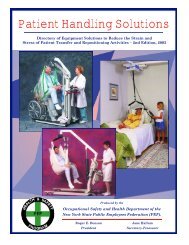American Educator, Winter 2010-11, Vol. 34, No. 4, AFT
American Educator, Winter 2010-11, Vol. 34, No. 4, AFT
American Educator, Winter 2010-11, Vol. 34, No. 4, AFT
You also want an ePaper? Increase the reach of your titles
YUMPU automatically turns print PDFs into web optimized ePapers that Google loves.
tion from the tests themselves, and to mitigate the expected<br />
negative effects of using tests for high-stakes purposes. In particular,<br />
designers of testing programs should take steps to reduce the<br />
likelihood of curriculum narrowing and score inflation. As mentioned<br />
above, basing the test on a detailed curriculum instead of<br />
broad standards will probably help. Another promising approach<br />
is to design tests to minimize predictability from one administration<br />
to another, so that focusing instruction on particular item<br />
formats or styles will not be viewed as likely means to raising<br />
scores. A single test administered at one point in time can sample<br />
only a fraction of the material in the curriculum, so varying this<br />
material over time, along with the types of items designed to mea-<br />
When we look beyond tests alone<br />
to meet our information and<br />
accountability needs, a wide range<br />
of better options become available.<br />
sure it, should result in reduced curriculum narrowing and score<br />
inflation. In short, if teachers had a high-quality curriculum and<br />
supporting materials at hand, and if the test were well-aligned but<br />
unpredictable, then teachers would probably just focus on helping<br />
all students master the skills and knowledge specified in the curriculum.<br />
Of course, the problem of testing higher-order knowledge<br />
and skills would remain, but in the near future technology<br />
may offer new opportunities to design cost-effective and highquality<br />
performance-based measures. 15<br />
Third, any accountability system that seeks to support<br />
instructional improvement ought to include a high-quality formative<br />
assessment system—one that is aligned with the curriculum<br />
and provides clear instructional guidance rather than<br />
simply predicting students’ scores on the state test. 16 But the<br />
assessment itself is just the beginning. The results must be accessible<br />
and available in a way that facilitates effective day-to-day<br />
use to guide instruction and be accompanied by ongoing professional<br />
development.<br />
Finally, a number of other considerations need to be addressed<br />
when designing the testing components of an accountability<br />
policy, such as whether to focus the system on student or educator<br />
performance, on individual or group performance, on current<br />
achievement or growth, and on fixed targets or participant rankings.<br />
17 These need not be such stark tradeoffs, but they do need to<br />
be considered. Many policymakers seem to want to say “All of the<br />
above,” but such an unfocused and unwieldy accountability system<br />
would be very unlikely to promote school improvement.<br />
52 AMERICAN EDUCATOR | WINTER <strong>2010</strong>–20<strong>11</strong><br />
Despite these challenges (and the dozens of more technical<br />
challenges that I have not addressed), it is likely<br />
that test-based accountability will be with us for some<br />
time. <strong>No</strong> doubt the policymakers who enthusiastically<br />
support such accountability are truly committed to school<br />
improvement—so they ought to see that heeding educators’ and<br />
researchers’ concerns about the purposes, meaningful uses, and<br />
technical limits of assessments is worthwhile. Working together,<br />
we can develop a program of large-scale assessment that<br />
addresses the information needs of educators, particularly at the<br />
classroom level, while also contributing to improved accountability<br />
policies. ☐<br />
Endnotes<br />
1. <strong>American</strong> Educational Research Association, <strong>American</strong> Psychological Association, and<br />
National Council on Measurement in Education, Standards for Educational and Psychological<br />
Testing (Washington, DC: <strong>American</strong> Psychological Association, 1999); and Michael T. Kane,<br />
“Validation,” in Educational Measurement, 4th ed., ed. Robert L. Brennan (Westport, CT:<br />
<strong>American</strong> Council on Education/Praeger, 2006), 17–64.<br />
2. For reviews of relevant literature, see Laura S. Hamilton, “Assessment as a Policy Tool,”<br />
Review of Research in Education 27, no. 1 (2003): 25–68; Jane Hannaway and Laura S.<br />
Hamilton, Accountability Policies: Implications for School and Classroom Practices<br />
(Washington, DC: Urban Institute, 2008); and Brian M. Stecher, “Consequences of<br />
Large-Scale, High-Stakes Testing on School and Classroom Practice,” in Making Sense of<br />
Test-Based Accountability in Education, ed. Laura S. Hamilton, Brian M. Stecher, and Stephen<br />
P. Klein (Santa Monica, CA: RAND, 2002).<br />
3. See, for example, Jennifer Booher-Jennings, “Below the Bubble: ‘Educational Triage’ and<br />
the Texas Accountability System,” <strong>American</strong> Educational Research Journal 42, no. 2 (2005):<br />
231–268.<br />
4. Brian M. Stecher, Frank Camm, Cheryl L. Damberg, Laura S. Hamilton, Kathleen J. Mullen,<br />
Christopher Nelson, Paul Sorensen, Martin Wachs, Allison Yoh, and Gail L. Zellman, Toward<br />
a Culture of Consequences: Performance-Based Accountability Systems for Public Services<br />
(Santa Monica, CA: RAND, <strong>2010</strong>).<br />
5. Laura S. Hamilton, Brian M. Stecher, Jennifer Lin Russell, Julie A. Marsh, and Jeremy Miles,<br />
“Accountability and Teaching Practices: School-Level Actions and Teacher Responses,” in<br />
Strong States, Weak Schools: The Benefits and Dilemmas of Centralized Accountability, ed.<br />
Bruce Fuller, Melissa K. Henne, and Emily Hannum, vol. 16, Research in Sociology of<br />
Education (St. Louis, MO: Emerald Group Publishing, 2008), 31–66; and Brian M. Stecher,<br />
Scott Epstein, Laura S. Hamilton, Julie A. Marsh, Abby Robyn, Jennifer Sloan McCombs,<br />
Jennifer Russell, and Scott Naftel, Pain and Gain: Implementing <strong>No</strong> Child Left Behind in Three<br />
States, 2004–2006 (Santa Monica, CA: RAND, 2008).<br />
6. Suzanne Lane, Carol S. Parke, and Clement A. Stone, “The Impact of a State Performance-Based<br />
Assessment and Accountability Program on Mathematics Instruction and<br />
Student Learning: Evidence from Survey Data and School Performance,” Educational<br />
Assessment 8, no. 4 (2002): 279–315.<br />
7. John B. Diamond, “Where the Rubber Meets the Road: Rethinking the Connection<br />
between High-Stakes Testing Policy and Classroom Instruction,” Sociology of Education 80,<br />
no. 4 (2007): 285–313; and William A. Firestone, David Mayrowetz, and Janet Fairman,<br />
“Performance-Based Assessment and Instructional Change: The Effects of Testing in Maine<br />
and Maryland,” Educational Evaluation and Policy Analysis 20, no. 2 (1998): 95–<strong>11</strong>3.<br />
8. See Daniel Koretz, Brian M. Stecher, Stephen P. Klein, and Daniel McCaffrey, “The<br />
Vermont Portfolio Assessment Program: Findings and Implications,” Educational<br />
Measurement: Issues and Practice 13, no. 3 (1994): 5–16.<br />
9. Daniel Koretz and Sheila Barron, The Validity of Gains in Scores on the Kentucky<br />
Instructional Results Information System (KIRIS) (Santa Monica, CA: RAND, 1998).<br />
10. Robert Rothman, Jean B. Slattery, Jennifer L. Vranek, and Lauren B. Resnick, Benchmarking<br />
and Alignment of Standards and Testing (Los Angeles: National Center for Research on<br />
Evaluation, Standards, and Student Testing, 2002).<br />
<strong>11</strong>. Brian M. Stecher and Tammi Chun, School and Classroom Practices during Two Years of<br />
Education Reform in Washington State (Los Angeles: National Center for Research on<br />
Evaluation, Standards, and Student Testing, 2001).<br />
12. Stecher et al., Pain and Gain.<br />
13. Marshall S. Smith and Jennifer O’Day, “Systemic School Reform,” in The Politics of<br />
Curriculum and Testing: The 1990 Yearbook of the Politics of Education Association, ed.<br />
Susan H. Fuhrman and Betty Malen (New York: Falmer Press, 1991), 233–267.<br />
14. Heidi Glidden, “Common Ground: Clear, Specific Content Holds Teaching, Texts, and<br />
Tests Together,” <strong>American</strong> <strong>Educator</strong> 32, no. 1 (Spring 2008): 13–19.<br />
15. Edys S. Quellmalz and James W. Pellegrino, “Technology and Testing,” Science 323, no.<br />
5910 (2009): 75–79; and Bill Tucker, Beyond the Bubble: Technology and the Future of<br />
Student Assessment (Washington, DC: Education Sector, 2009), 1–9.<br />
16. Marianne Perie, Scott Marion, Brian Gong, and Judy Wurtzel, The Role of Interim<br />
Assessments in a Comprehensive Assessment System: A Policy Brief (Washington, DC:<br />
Achieve, Aspen Institute, and National Center for the Improvement of Educational<br />
Assessment, 2007).<br />
17. See, for example, Michael J. Podgursky and Matthew G. Springer, “Teacher Performance<br />
Pay: A Review,” Journal of Policy Analysis and Management 26, no. 4 (2007): 909–950.





